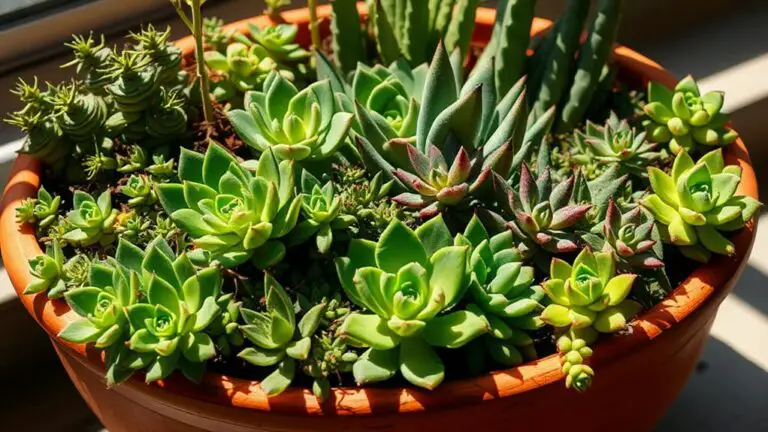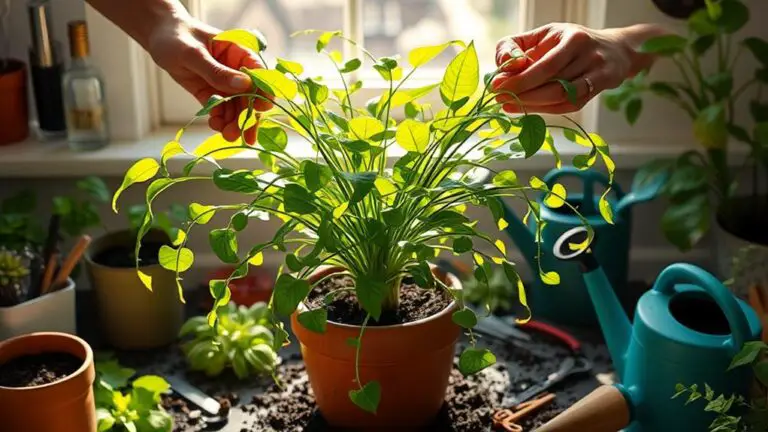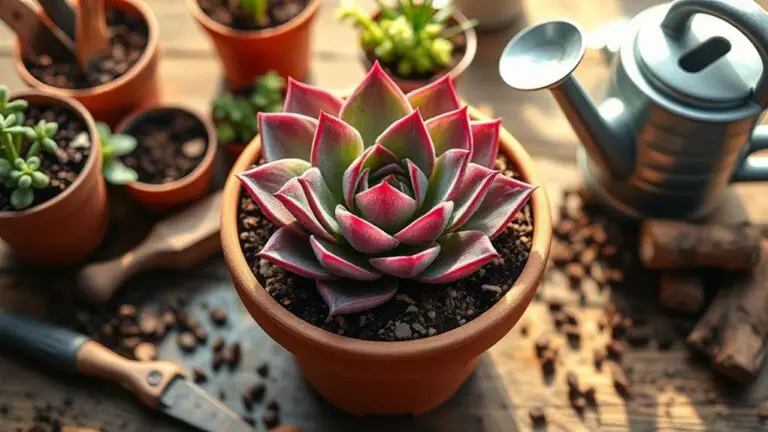Combat Bacterial Infections: 7 Steps to Prevent Soft Rot in Your Succulents
If you've ever dealt with the frustration of soft rot in your succulents, you know how essential it is to prevent bacterial infections before they start. Implementing a few key practices can make all the difference in keeping your plants healthy. You'll want to start by ensuring proper watering habits, as too much moisture is often the culprit. But it doesn't stop there—adequate air circulation and regular inspections are just as important. Curious about the remaining steps to safeguard your succulents? Let's explore how you can create an ideal environment for them to thrive.
Ensure Proper Watering

Proper watering is vital to preventing soft rot in succulents. You need to guarantee proper watering to keep your succulents healthy and vibrant. Start by only watering when the soil is dry to the touch. Excess moisture can lead to bacterial soft rot, which is every succulent lover's nightmare.
Using well-draining soil mixes specifically designed for succulents helps prevent water retention and creates an environment where bacteria can't thrive.
When it comes to irrigation methods, aim to water directly at the base of the plant. This avoids splashing and keeps moisture off the leaves, which is important for preventing soft rot. Overhead watering can increase the risk of bacterial growth, especially in high humidity conditions.
Monitor your soil moisture levels regularly. This helps you adjust your watering schedule based on the needs of your plants. For instance, during periods of high heat or humidity, succulents may require less frequent watering.
Guaranteeing good air circulation is also key, but we'll dive deeper into that later.
Maintain Air Circulation
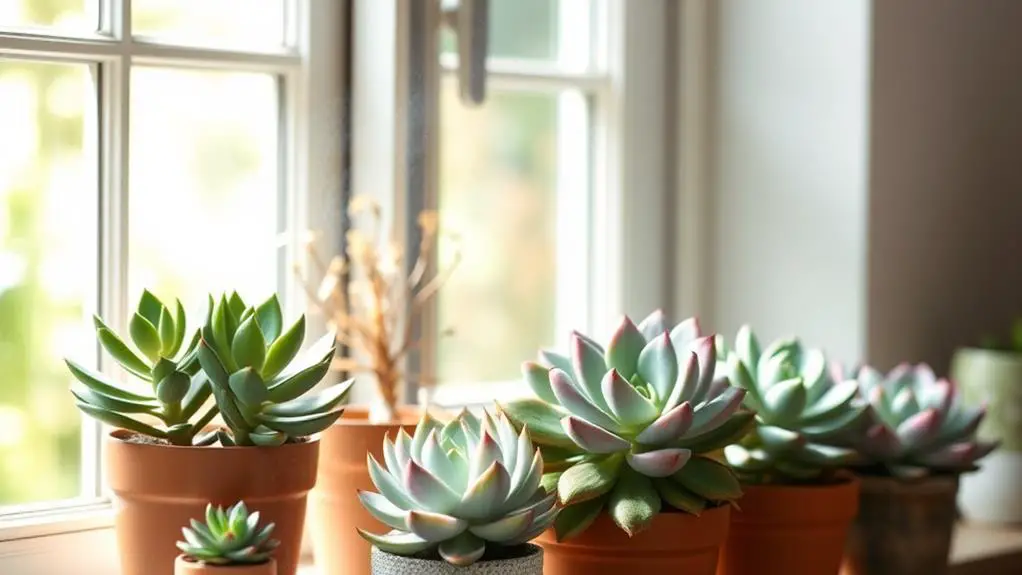
To keep your succulents healthy, guarantee proper ventilation by spacing them adequately and reducing indoor humidity.
You can place them in well-ventilated areas or use fans to enhance air circulation, which helps dry out any excess moisture.
Regularly rotating the pots and choosing open placements like shelves or hanging arrangements will also keep the air flowing and prevent bacterial infections.
Ensure Proper Ventilation
Maintaining good ventilation is key to keeping your succulents healthy and free from soft rot. Proper ventilation helps reduce humidity levels around your plants, which can otherwise lead to bacterial growth. By guaranteeing adequate air circulation, you're giving your succulents the best chance to thrive.
Start by spacing your plants appropriately. This allows air to flow freely between them and reduces moisture retention, which can cause soft rot. Position your succulents in bright, well-ventilated areas like near windows or in open spaces. This enhances air movement and discourages stagnant moisture.
If you're growing succulents indoors, using fans can greatly improve airflow. Fans create an environment where bacteria that thrive in high humidity can't easily grow. It's a simple way to keep your plants healthy.
Don't forget to regularly inspect and trim any overcrowded foliage. This not only keeps your plants looking neat but also guarantees that air can circulate effectively around the leaves and stems. Healthy plants need adequate air flow to maintain their vigor and resist infections.
Reduce Indoor Humidity
Keeping indoor humidity in check is essential for preventing soft rot in your succulents. Moisture buildup can lead to bacterial infections that damage your plants' healthy tissue.
By reducing indoor humidity and maintaining good air circulation, you can create an environment where your succulents thrive.
To help you reduce indoor humidity, follow these steps:
- Use Fans: Place a small fan near your succulents to keep air moving. This helps prevent moisture buildup and keeps the humidity level within the ideal range of 30% to 50%.
- Open Windows: Regularly opening windows allows fresh air to circulate, reducing humidity levels. Proper ventilation is key to keeping your succulents in well-ventilated areas.
- Use a Dehumidifier: If your indoor space is particularly humid, a dehumidifier can be a great solution. It will help maintain the ideal humidity level and prevent bacterial infections like soft rot.
- Avoid Overcrowding: Give your succulents enough space to guarantee good air circulation. Overcrowding can trap moisture and increase the risk of soft rot.
Space Plants Adequately
When it comes to preventing soft rot in your succulents, spacing your plants adequately is vital. Adequate spacing enhances air circulation, which helps reduce humidity levels around the foliage. This step is significant for preventing bacterial infections like soft rot. Aim for a spacing of at least 6 to 12 inches between plants, depending on their mature size. This guarantees that air can flow freely and moisture doesn't accumulate.
Increased air circulation decreases the likelihood of stagnant moisture, a key factor that promotes the growth of bacteria responsible for soft rot. Regularly prune or remove any overcrowded or overlapping foliage to maintain ideal spacing and improve ventilation around your succulents. Overcrowded foliage can trap moisture, making your plants more susceptible to bacterial infections.
Positioning plants in well-ventilated areas, such as near windows or outdoor spaces with good airflow, further supports the prevention of soft rot by allowing moisture to evaporate quickly. Securing good ventilation is a simple yet effective way to keep your succulents healthy.
Inspect for Disease Signs

To keep your succulents healthy, it's important to inspect them regularly for signs of soft rot.
Look for yellowing, browning, or blackened areas at the base of the plant, as well as mushy, water-soaked spots on leaves and stems.
A foul odor and leaves that fall off easily are also strong indicators of infection, so act quickly if you notice these symptoms.
Common Rot Symptoms
Soft rot in succulents manifests through several telltale signs that you shouldn't ignore. Identifying these symptoms early can save your plant from severe damage. Pay attention to the following indicators:
- Discolored Tissue: You might notice the base of your succulent turning yellow, brown, or black. This color change is a sign of tissue damage caused by bacterial infection.
- Mushy Spots: Soft, mushy areas on the plant's surface are a clear symptom. These spots are a result of cell wall breakdown and often come with a foul smell, similar to decaying organic matter.
- Falling Leaves: If leaves fall off easily or show black or brown spots surrounded by yellow halos, your succulent is probably suffering from soft rot. This weakening is a response to bacterial infection.
- Water-Soaked Lesions: As the disease progresses, watch for water-soaked lesions that expand and become sunken. These lesions indicate severe internal tissue breakdown.
Early Detection Techniques**
Catching soft rot in its early stages can make all the difference in saving your succulents. Start by regularly inspecting your succulents for initial color changes to yellow, brown, or black, especially at the base. These changes often signal the onset of soft rot. Look for mushy, soft spots on the plant tissue, as these are signs of cell wall breakdown caused by bacterial disease.
Pay attention to any foul odors coming from your plant. A bad smell can indicate tissue decomposition associated with bacterial soft rot. Monitor for leaves that easily detach, as this could mean significant weakening of the plant structure due to rot. Also, check for black or brown spots surrounded by yellow halos, as these may suggest a fungal or bacterial infection needing immediate care.
Inspect succulents thoroughly and consistently to catch these early signs. Your efforts in early detection will help maintain your plant health and prevent the spread of soft rot.
| Symptom | Indicator | Action Needed |
|---|---|---|
| Color changes (yellow, brown, black) | Onset of soft rot | Inspect and isolate infected parts |
| Mushy, soft spots | Cell wall breakdown | Remove affected areas |
| Foul odors | Tissue decomposition | Improve air circulation |
Your vigilance can keep your succulents thriving!
Use Clean Tools
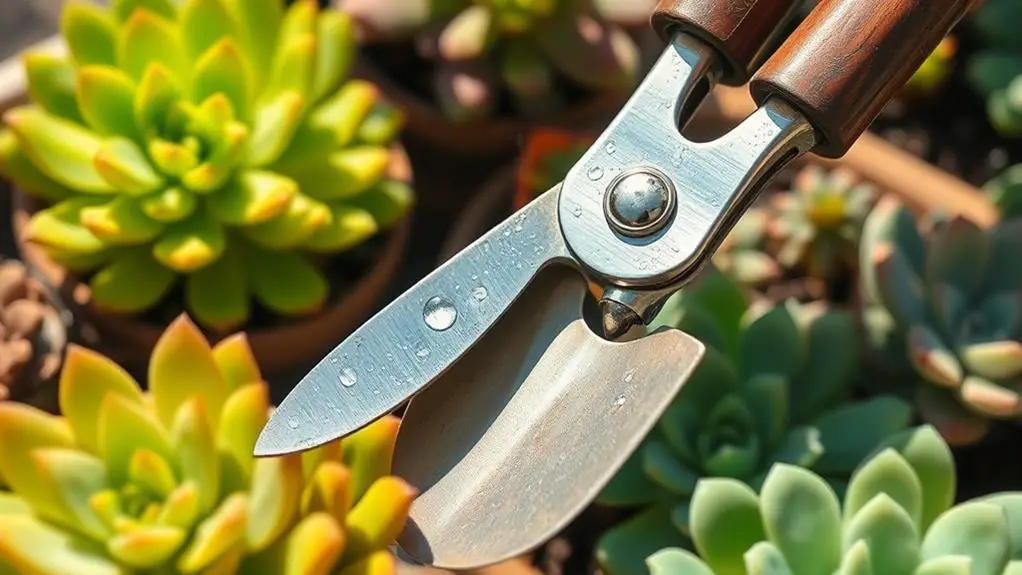
A crucial step in preventing soft rot in your succulents is using clean tools. Soft rot bacteria can easily spread through contaminated tools, so sterilizing your gardening tools helps reduce the risk of bacterial infections.
Let's explore how to keep your tools clean and your plants healthy.
First, always sterilize your tools before use. You can do this by wiping them down with a bleach solution or rubbing alcohol.
Second, make a habit of cleaning your pots and containers regularly. Bacteria from previous plants can linger and infect new ones if not properly disinfected.
Third, use separate tools for different plants, especially if you notice any signs of disease. This simple step can greatly reduce the risk of cross-contamination.
Finally, avoid using rusty or damaged tools. Not only can they harbor bacteria, but they can also create wounds on your succulents that make it easier for bacteria to enter.
Here's a quick checklist to help you remember:
- Sterilize tools with bleach or alcohol before use.
- Clean and disinfect pots and containers regularly.
- Use separate tools for different plants.
- Avoid rusty or damaged tools.
Provide Adequate Drainage

Guaranteeing your succulents have adequate drainage is one of the most significant steps in preventing soft rot. To start, use well-draining soil mixes like those containing sand or perlite. These materials prevent excess moisture, which can lead to soft rot and bacterial growth.
Make certain your pots have drainage holes at the bottom. These holes let excess water escape, reducing the risk of waterlogged soil. Opt for terracotta pots. They're porous and help absorb moisture, providing better drainage than plastic pots.
Elevate your pots on pot feet or trays with drainage channels. This step allows airflow around the base and prevents standing water, which can cause root rot. Regularly check the soil condition. If it seems too compacted or retains too much water, repot your succulents into fresh, well-draining soil. Maintaining ideal drainage is essential for healthy, happy succulents.
| Soil Type | Pot Material | Additional Tips |
|---|---|---|
| Sand/Perlite Mix | Terracotta | Elevate pots to prevent standing water |
| Well-Draining | Porous | Confirm pots have drainage holes |
| Succulent Mix | Non-Plastic | Regularly inspect and repot if needed |
Avoid Crowded Planting
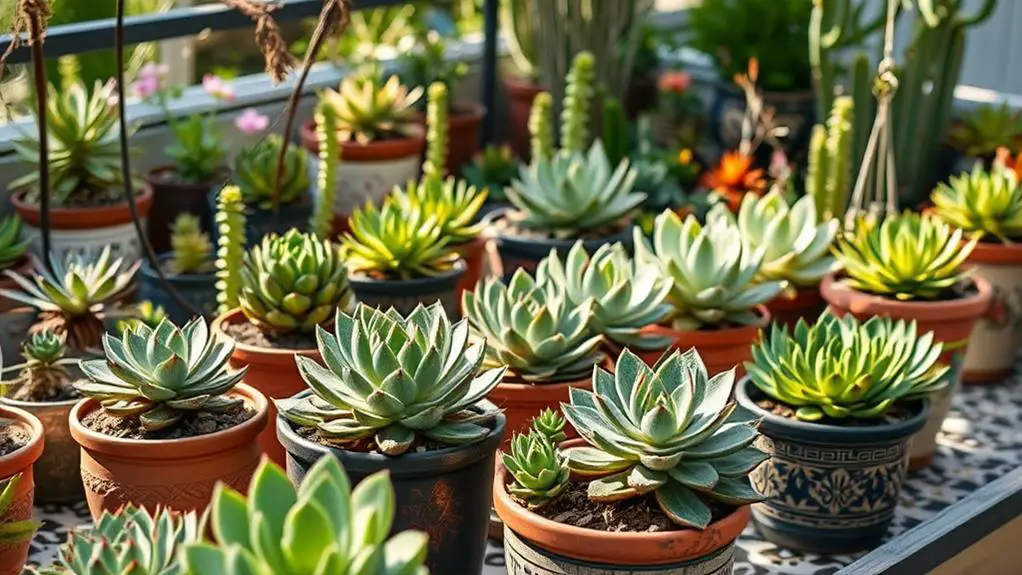
It's vital to avoid crowded planting when you're growing succulents. When succulents are too close together, it restricts air circulation, creating a humid environment where bacteria thrive. This can lead to soft rot, a common issue that can devastate your plants.
To prevent this, proper spacing and good airflow are important.
Here are four steps to help you avoid crowded planting and keep your succulents healthy:
- Maintain Adequate Spacing: Make sure there's at least 6-12 inches between each succulent. This spacing reduces competition for nutrients and water, making plants less susceptible to bacterial infections.
- Promote Airflow: Good airflow helps reduce humidity around your succulents. Avoid placing plants too close to each other or near walls that can block air movement.
- Regular Thinning: If your succulents start growing too densely, thin them out regularly. Removing some plants will lower the risk of humidity build-up and bacterial growth.
- Monitor Growth: Keep an eye on your succulents' growth. If they begin to encroach on each other's space, it's time to replant them with better spacing.
Practice Good Sanitation
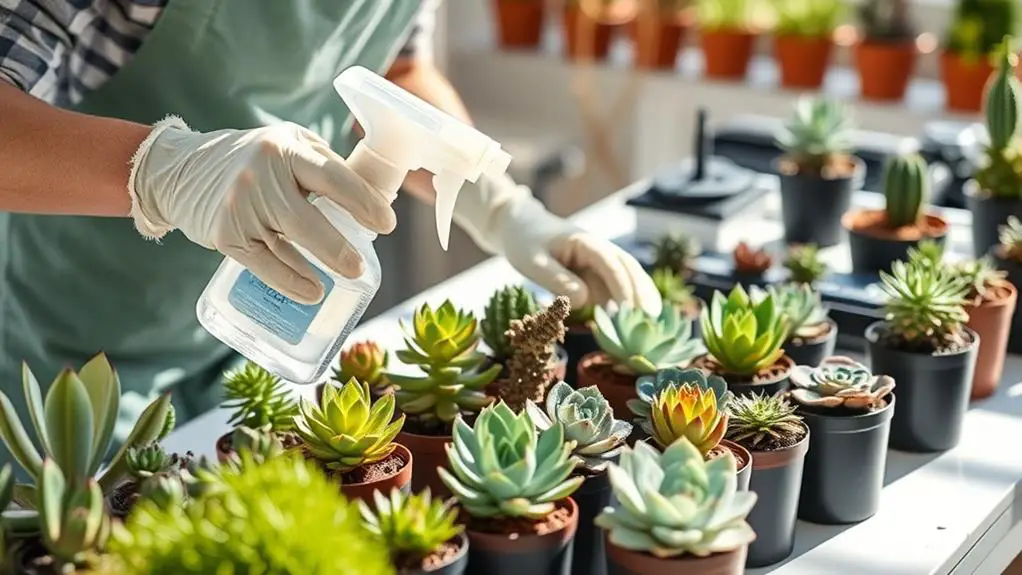
To keep your succulents free from soft rot, practice good sanitation diligently. Start by regularly cleaning and disinfecting your gardening tools. Use a bleach solution or rubbing alcohol to eliminate any potential bacteria before and after use. This step guarantees that you're not transferring harmful pathogens to your plants.
When repotting your succulents, always use sterilized pots and containers. Bacteria can linger in previously used materials, so clean pots are a must.
Also, remember to remove any fallen leaves or debris from the soil surface. Decaying organic matter can harbor bacteria and lead to infections.
Avoid handling your succulents when they're wet. Moisture can easily transfer bacteria from one plant to another through touch. It's best to wait until your plants are dry before you tend to them.
Implement a routine inspection of your succulents. Look for any signs of rot, pests, or other issues. If you catch problems early, you can address them promptly and maintain a healthy growing environment.
Frequently Asked Questions
How to Prevent Bacterial Soft Rot?
To prevent bacterial soft rot, use well-draining soil, water only when dry, and maintain low humidity. Inspect plants regularly for pests or damage, sterilize tools before use, and guarantee good air circulation around your succulents.
How Do You Fix Soft Rot in Succulents?
To fix soft rot in your succulents, isolate the infected plant. Use sterilized tools to remove diseased parts, let the plant dry, then replant in fresh soil. Improve air circulation and adjust watering to prevent future infections.
How to Cure Soft Rot?
You can't cure soft rot, but you can manage it. Cut away all infected tissue using sterilized tools, let the healthy parts dry, and replant in fresh, well-draining soil. Monitor and maintain proper care practices to prevent recurrence.
What Is the Bacterial Soft Rot on Succulents?
Bacterial soft rot is caused by Pectobacterium carotovorum. You'll notice color changes, mushy spots, and a foul odor. It thrives in warm, humid conditions with poor drainage. Bacteria enter through wounds or damage, leading to irreversible decay.
Conclusion
By following these seven steps, you'll keep your succulents healthy and free from soft rot. Remember to water them properly, guarantee good air circulation, and check regularly for disease. Use clean tools, provide adequate drainage, avoid overcrowding, and practice good sanitation. You've got this! With a little care and attention, your succulents will thrive. Gardening can be rewarding and fun, so don't be afraid to get your hands dirty and enjoy the process.


